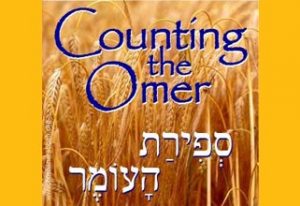There is a tradition that the Israelites stood at the shores of the sea of reeds on the 7th day of Passover. We read the Song at the Sea today. This service is so long that I skipped my remarks. Here is what I would have said today.
Today we stand on the brink. We are on the shores of the Sea of Reeds. In front of us a wall of water, beautiful but we don’t know how we can get across it. Behind us we can hear the thundering footstep of Pharaoh’s approaching, chasing army. What should we do? What can we do? Each of us just experienced a miracle. We were brought out of Egypt, out of the narrow places, with a mighty hand and an outstretched arm. Now the fear is palpable. Is this the end? Why would Moses bring us here? We might be better off back in Egypt. People are starting to rumble. Oh no!
Then GOD said to Moses, “Why do you cry out to Me? Tell the Israelites to go forward. And you lift up your rod and hold out your arm over the sea and split it, so that the Israelites may march into the sea on dry ground… Then Moses held out his arm over the sea and GOD drove back the sea with a strong east wind all that night, and turned the sea into dry ground. The waters were split.
It wasn’t easy. It wasn’t a slam dunk as they say in the basketball world. Yes, Moses held up his staff. And it took time. It wasn’t a Charleston Heston moment or a Val Kilmar one. The people were hesitant. Yet one guy, Nachson ben Aminidav, waded into the water. First a toe. Then up to his nostrils. The story appears both in the midrash and the Talmud. (Mechilta, Beshalach 5; Pirkei d’Rabbi Eliezer 42; Exodus Rabbah 13; and others. Sotah 37a.)
This story should inspire us. It inspired King David who wrote,“I have sunk in muddy depths, and there is no place to stand; I have come into the deep water, and the current has swept me away . . . Let not the current of water sweep me away, nor the deep swallow me, and let the well not close its mouth over me.” (Psalms 69:3, 16)
We will not be swept away. We will be like Nachson and act.
Rabbi Menachem Schneerson, known as The Rebbe saw Nachshon’s deed as a call to action: “One fellow named Nachshon jumped into the sea, and caused the great miracle of the Splitting of the Sea. Technically, he was under no obligation to do so. But he knew that G‑d wanted Israel to move onward toward Sinai. So he did what he needed to do. There was a sea in his way. So he jumped into the sea and plowed on toward his goal. “The lesson for all of us is that we must stay focused on our life’s mission, disregarding all obstacles.” ((From a talk on 10 Shevat 5716) Chabad adds, “Nachshon’s name has become synonymous with courage and the will to do the right thing, even when it’s not popular.”
The Rev. Ginny McDaniel once asked me how the Jewish people see freedom. She was wrestling with whether prize freedom from something or for something. Those little prepositions mean a lot. In this country we are guaranteed by the Bill of Rights, the first 10 Amendments to the Constitution certain freedoms. That could be an important discussion today as our friends in Boston re-enact the battle from Boston to Lexington and Concord. You remember the poem, “Listen my children and you shall hear of the midnight ride of Paul Revere. On the 18th of April in ‘75. Hardly a man is now alive to remember that famous day and year.” What were those patriots, those minutemen fighting for? What do we all fight for?
One of those rights is to life, liberty and the pursuit of happiness. That got codified in the Constitution and the amendments. The first amendment in the Bill of Rights says. “Congress shall make no law respecting an establishment of religion, or prohibiting the free exercise thereof; or abridging the freedom of speech, or of the press; or the right of the people peaceably to assemble, and to petition the Government for a redress of grievances.” We talk about that as freedom of religion.
Simon’s haggadah has this quote, probably from Chaim Stern. It still resonates, maybe even more so this year:
“Tonight, we participate as members of multiple communities. As Jews, the Exodus is our heritage, a equality, justice and peace are our dreams…
Freedom from bondage and freedom from oppression
Freedom from hunger and freedom from want
Freedom from hatred and freedom from fear
Freedom to think and freedom to speak
Freedom to teach and freedom to learn
Freedom to love and freedom to share
Freedom to hope and freedom to rejoice
Soon, in our days Amen.”
That’s how I answered Ginny.
Freedom. We talked about it some last night. For those gathered it includes freedom to drive and freedom to travel. Freedom to assemble and freedom to speak one’s mind. For me it includes freedom to run and freedom to swing on a swing. Moshe Dayan said: “Freedom is the oxygen of the soul.”
Passover is a very layered tradition. I’ve been thinking about that all week. The kids who helped in the kitchen this week will no doubt remember that all the days of their life. During Torah Study I told the story of my mother stealing, yes stealing apple sauce from Chute Middle School because the North Shore School of Jewish Studies had forgotten about charoset. No one will forget this year, or the year my father was in the hospital and he sent a telegram as Elijah.
We are commanded to remember what the Lord did for us when we went forth from Egypt. To get the children to ask why. Why are we doing this? Why is this night different. And even in our most joyous moments, Passover, Shavuot, Sukkot and yes, Yom Kippur we add yizkor which we will do shortly. We remember. We remember that even in their haste, Moses remembered to take the bones of Joseph with him.
We stand on the brink. When we got to the other side, because of G-d, Moses and Nachson, we sang.
Mekhilta teaches us that while Ezekiel and Isaiah had visions of the Divine, “even a slave woman at the shore of the sea, saw directly the power of the Almighty in splitting the sea. All recognized in that instant their personal redemption and therefore all of them opened their mouths to sing in unison.
Rabbi Sandy Sasso has just written a delightful children’s book. Miriam’s Dancing Shoes. It begins “It was time. Time to leave Egypt. Time for slavery to end. Time to be free.” But the people were not quite ready. They complained. About everything. But not Miriam. She carried a timbrel and her DANCING SHOES.! I have often wondered about this. Of all the things I could grab, I am not sure I would remember my tambourine! They followed her and her dancing shoes and the jingle of her tambourine. Think about that the next time we shake the rimonim putting away the Torah. She explained to Moses, that this is the song of hope. This is the song of freedom.
“Then Miriam the prophetess, Aaron’s sister took a timbrel in her hand, and all the women went out after her with timbrels and with dancing. And Miriam chanted for them, “Sing to the Lord, who has triumphed gloriously. Horse and rider were thrown into the sea.”
We stand on the brink. And we must learn to sing again. Whether it is in the voice of Val Kilmar , of blessed memory and the others in Prince of Egypt https://www.youtube.com/watch?v=ocOs1zes4IA or Debbie Friedman in “Miriam’s Song” https://www.youtube.com/watch?v=QZdSEsZ8bMo or https://www.youtube.com/watch?v=M-olta6pVKIn
Freedom requires that we take responsibility. As Central Synagogue reminds us that Martin Buber said, “The world needs redemption as an act of grace, and our responsibility is to make it worthy through our actions and beliefs,”
So we stand on the brink. We put our toe in the water as Nachson did. As the Rebbe urges us or as another Menachem, Rabbi Menachem Creditor urges:
“So go we must. Not alone. Not leaving anyone behind. When Pharaoh asked, “Who will go with you?” Moses replied, “Our elders and our children, our sons and our daughters.” Everyone.
Freedom means everyone.
And let me say it plainly: if we call it freedom but we’ve left someone behind—someone poor, someone disabled, someone forgotten, someone who looks or loves or prays differently—it’s not freedom. Not in the Jewish sense. Not in the holy sense. Not the kind we sing about at our Seders.
I want no blood on my door if it means someone else must suffer. I want no celebration if it means someone else is left mourning. Yes, we sometimes must fight for freedom—but never with joy for the fight itself. Never with pride in the pain.
So this is my promise, and I invite you to make it with me:
I will step into the sea.
I will not do it alone.
I will hold the hand of someone who needs me, and I will let others hold mine.
I will remember that my freedom is meaningless unless it includes yours.
I will stand in the breach, even when I’m afraid, because faith demands courage before certainty.
And when I pray, I will listen for the echo of my own voice telling me what I must do.
The sea is waiting, friends. The wind has begun to blow. The moment is upon us.
Let’s show up for each other.
Let’s split the sea—together.”

Giant waves parting the sea isolated on white, 3d render.
This portion gives me hope. I will join with Nachson, with Miriam, with that lowly bond woman, with both Menachem’. Together we will split the sea and come out on the other side. Joyously.
 There are 50 days between the Second Night of Passover and Shavuot, which this year begins the evening of June 1. For many years I have taken on a personal project. Some years it has been as simple as remembering to buckle my seat belt, or unpacking one box a day. (That one isn’t simple!). One year I finished the draft of a book.
There are 50 days between the Second Night of Passover and Shavuot, which this year begins the evening of June 1. For many years I have taken on a personal project. Some years it has been as simple as remembering to buckle my seat belt, or unpacking one box a day. (That one isn’t simple!). One year I finished the draft of a book. 
